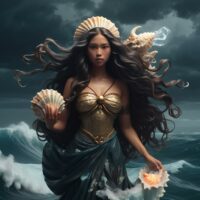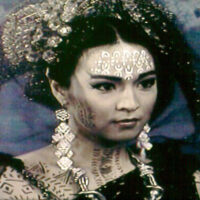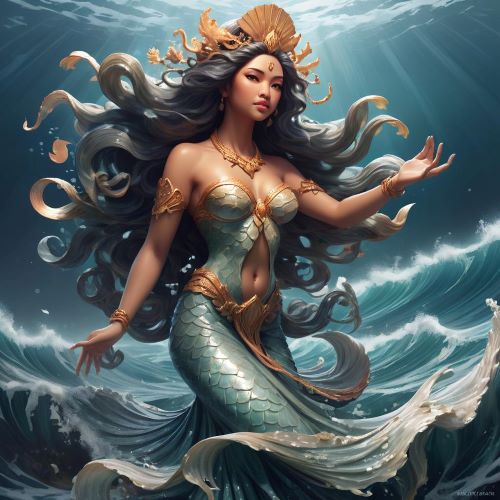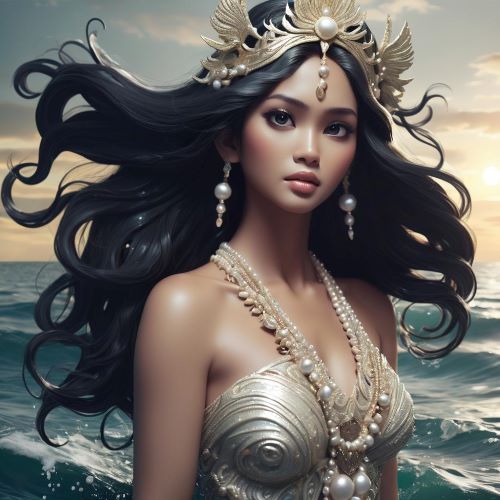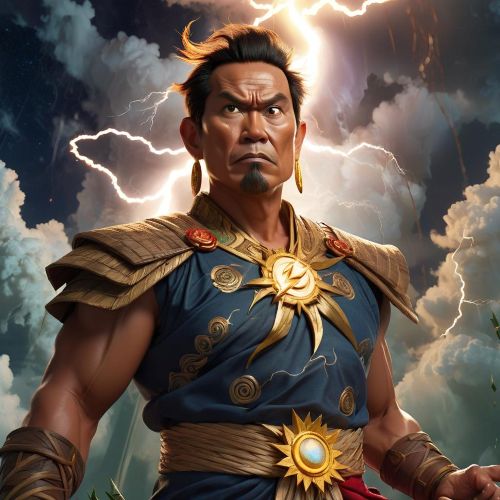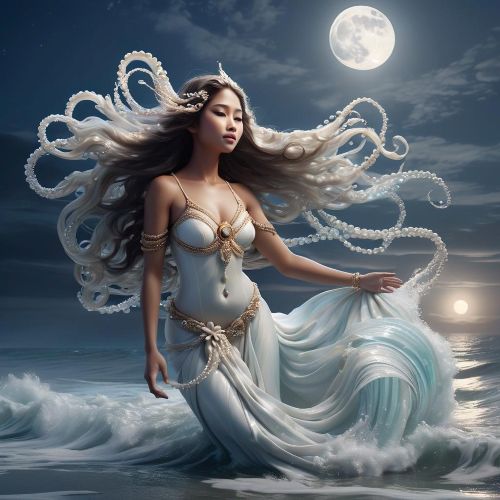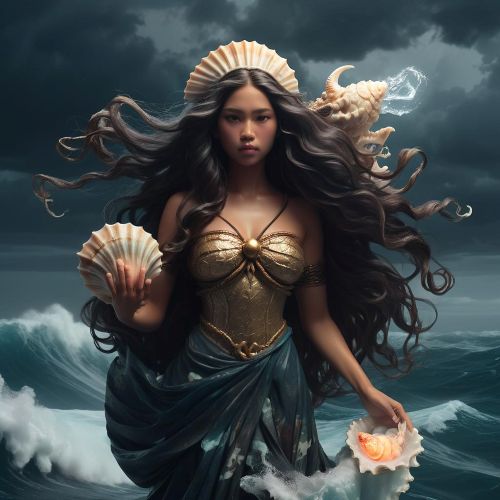
Magwayen : Goddess of the Sea
Listen
At a glance
| Description | |
|---|---|
| Origin | Philippine Mythology |
| Classification | Gods |
| Family Members | Kaptan (Husband), Lidagat (Daughter) |
| Region | Philippines |
| Associated With | Sea, Underworld |
Magwayen
Introduction
Magwayen, also spelled Maguayen or Maguayan, stands as a pivotal figure in Visayan mythology from the Philippines. She is the goddess of the sea and death, revered as one of the primordial deities who shaped the universe in early creation stories. Her presence extends beyond the ocean’s vast horizon, touching on the realms of life, death, and spiritual transition. As the embodiment of the nurturing yet unpredictable nature of the sea, Magwayen plays a dual role: she is both a giver of sustenance and a fierce force of destruction. Alongside Kaptan, the god of the sky, she is said to have co-created the world, making her essential to the mythological origins of the archipelago. Her legacy remains deeply woven into the spiritual and cultural beliefs of the Filipino people.
Physical Traits
Magwayen is often envisioned as a graceful, mature woman whose appearance resonates with the raw power and serenity of the sea. Traditional depictions imagine her hair cascading like waves and her body blending seamlessly with the water, reflecting her intimate bond with the ocean. In ceremonial stories, she carries a budyong—a sacred conch shell—used to summon spirits or exert control over natural forces. When she takes on her psychopomp role, ferrying the dead across the river to the underworld, her appearance transforms. She dons dark, mourning garments, her face covered with a veil that marks her shift from life-giver to death guide. This dual visual narrative mirrors her spiritual significance—maternal and fierce, serene and somber.
Family
Within the mythological family tree, Magwayen’s role is fundamental. She is considered the divine counterpart of Kaptan, the sky god, and through their union, they produced important deities who further shaped the world. Their daughter, Lidagat, inherited her mother’s dominion over the sea, continuing the line of water-associated divinities. Lidagat’s marriage to Lihangin, the god of wind and Kaptan’s son, symbolizes the elemental harmony between sea and sky. This union gave birth to deities like Licalibutan, Liadlao, Libulan, and Lisuga—each representing aspects of the earth, sun, moon, and stars. Magwayen’s influence stretches through generations of gods, anchoring her place as a matriarch of both divine creation and cosmic balance.
Other names
Magwayen is known by several variations of her name, influenced by the regional dialects and oral traditions across the Visayas. While “Magwayen” is the most widely used spelling in modern retellings, older texts and oral accounts also refer to her as Maguayen, Mama Guayen, or Maguayan. These variations hint at the evolution of her worship over centuries and the adaptability of her mythos among different tribes. Her name is also linked to kawayan (bamboo), which appears in the creation story where the first man and woman emerge from a split bamboo stalk—a metaphor for Magwayen’s association with birth, beginnings, and life’s continuity.
Powers and Abilities
Magwayen wields immense power over both the physical and spiritual realms. As the goddess of the sea, she commands tides, waves, and aquatic life. Her mood can summon calm waters or violent tempests, reinforcing her control over nature. In her spiritual role, Magwayen functions as a psychopomp—a guide for the souls of the dead. She navigates the souls across the river Lalangban to Sulad, the underworld, using a mystical balangay or Butuan boat, an ancient Filipino watercraft. The journey she oversees is not merely transportation but a sacred passage into the afterlife. In some stories, she possesses transformative abilities, calling upon the power of her conch shell to change forms or confront sea monsters like Bakunawa, the moon-eating serpent. Her role in both creation and destruction reflects the eternal balance that sustains the natural and supernatural worlds.
Modern Day Influence
Magwayen’s legacy endures far beyond the bounds of ancient myth. Despite centuries of colonial influence and religious conversion, her story continues to resonate in Filipino cultural consciousness. She features prominently in oral folklore still told in Visayan communities, her name evoked in stories passed from elders to younger generations. In popular media, Magwayen has been reimagined in television series like Amaya and Indio, where she is portrayed as a powerful sea goddess, embodying themes of femininity, strength, and ancestral wisdom. These portrayals reintroduce her mythology to modern audiences and reassert her relevance in contemporary storytelling.
Beyond entertainment, Magwayen’s symbolism has inspired environmental activism. As a protector of the seas, she is invoked in discussions about ocean conservation, sustainable fishing, and the ecological impact of climate change on island nations. In spiritual and neo-pagan communities, she is often honored as a divine mother figure who represents the cycles of life and death. Her dual nature—nurturing and wrathful—makes her a powerful emblem of balance, reminding believers of the consequences of disrupting nature’s harmony.
Related Images
Source
Clark, J. (2016). Visayan Deities in Philippine Mythology. The Aswang Project. Retrieved from https://www.aswangproject.com/visayan-deities-in-philippine-mythology/
Gancayco, S. (2016). Magwayen, Bisayan Goddess of the Sea & Underworld. Hella Pinay. Retrieved from https://www.hellapinay.com/article/2016/11/16/magwayen-bisayan-goddess-of-the-sea
Loarca, M. (1582). Relacion de las Yslas Filipinas. In Blair & Robertson (Eds.), The Philippine Islands (Vol. 5).
Wikipedia contributors. (n.d.). Magwayen. Wikipedia. Retrieved from https://tl.wikipedia.org/wiki/Magwayen
Caballes, L. (2024). The Bisayan Deities: Who Were the Gods & Goddesses?. The Pinay Writer. Retrieved from https://thepinaywriter.com/the-bisayan-deities-who-were-the-gods-goddesses/
Horror Chronicles. (2024). Magwayen: The Goddess of the Sea and the Underworld in Visayan Mythology. Retrieved from https://horrorchronicles.com/magwayen/
Frequently Asked Questions
What is lorem Ipsum?
I am text block. Click edit button to change this text. Lorem ipsum dolor sit amet, consectetur adipiscing elit. Ut elit tellus, luctus nec ullamcorper mattis, pulvinar dapibus leo.
What is lorem Ipsum?
I am text block. Click edit button to change this text. Lorem ipsum dolor sit amet, consectetur adipiscing elit. Ut elit tellus, luctus nec ullamcorper mattis, pulvinar dapibus leo.
What is lorem Ipsum?
I am text block. Click edit button to change this text. Lorem ipsum dolor sit amet, consectetur adipiscing elit. Ut elit tellus, luctus nec ullamcorper mattis, pulvinar dapibus leo.
What is lorem Ipsum?
I am text block. Click edit button to change this text. Lorem ipsum dolor sit amet, consectetur adipiscing elit. Ut elit tellus, luctus nec ullamcorper mattis, pulvinar dapibus leo.
What is lorem Ipsum?
I am text block. Click edit button to change this text. Lorem ipsum dolor sit amet, consectetur adipiscing elit. Ut elit tellus, luctus nec ullamcorper mattis, pulvinar dapibus leo.


